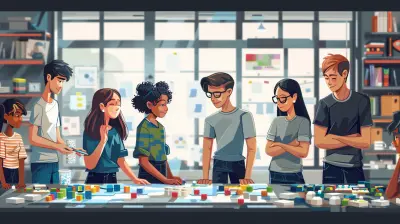The Power of Backward Design in Crafting Meaningful Curriculum
18 October 2025
Designing an effective curriculum can feel a bit like trying to piece together a jigsaw puzzle—without knowing what the final picture looks like. It can be overwhelming, especially when you’re unsure of where to start or which direction to take. That’s where backward design comes into play. In education, backward design is like flipping that jigsaw puzzle box over so you can see the final image. You’re starting from the end and working your way back to ensure every piece fits and makes sense.
But what exactly is backward design, and why is it such a powerful tool for educators? Buckle up, because we’re about to dive deep into how this method can transform your approach to curriculum planning and make learning more meaningful for your students.
What Is Backward Design?
Let’s get the basics down first. Backward design is a framework for curriculum planning where you start with the end in mind. Instead of beginning with lesson activities or textbooks, you focus on the desired learning outcomes first. Essentially, you ask yourself, “What do I want my students to know and be able to do by the end of this course or unit?” Once you’ve established your goals, you work backwards to design assessments and learning activities that will guide students toward those outcomes.This method was popularized by Grant Wiggins and Jay McTighe in their book Understanding by Design (UbD), and it has since become a cornerstone of effective curriculum development.
The Three Stages of Backward Design
Backward design typically follows three key stages:1. Identify Desired Results: What knowledge, skills, and understandings do you want your students to take away? These are your learning objectives.
2. Determine Acceptable Evidence: How will you know if students have achieved these objectives? What will you accept as evidence of learning? These include your assessments.
3. Plan Learning Experiences and Instruction: What activities, lessons, and resources will best help your students achieve the desired results? This is where you design your instruction.
Now that we’ve got the foundation, let’s break this down even further.
The Power of Starting With the End in Mind
Imagine you’re planning a road trip. Would you start driving without knowing where you’re going? Probably not. You’d map out your destination first, and then figure out the best route to get there. That’s exactly what backward design does for your curriculum. By focusing on the outcomes first, you ensure that every lesson, activity, and assessment is aligned with where you want students to end up.Why This Matters
When you plan lessons without clear goals, it’s easy to get lost in the day-to-day hustle of content delivery. You might cover a bunch of topics, but are your students actually learning what they need to? Or are they just cruising through without a clear sense of purpose?Backward design ensures that every part of your teaching is intentional. It helps you avoid what Wiggins and McTighe call “activity-oriented teaching,” where the focus is more on doing activities than achieving learning goals. By starting with the end, you create a roadmap that keeps both you and your students on track.
How Backward Design Creates Meaningful Learning Experiences
Okay, so we've established that backward design is practical, but how does it make learning more meaningful?1. Clarity for Educators and Students
One of the greatest benefits of backward design is clarity. When you’re clear about your learning objectives, you can communicate them effectively to your students. They know what’s expected of them, and you know what to focus on. This clarity fosters a sense of purpose in the classroom, which naturally leads to more engagement.Think about it: if your students know exactly why they’re learning something and how they’ll be assessed, they’re more likely to be motivated to meet those expectations. It’s like walking into a game where you know the rules in advance—it’s a lot easier to play when you understand the goals.
2. Aligned Assessments
Backward design ensures that your assessments are directly aligned with your learning objectives. This is crucial because if your assessments don’t measure what you want students to learn, how will you know if they’ve actually mastered the material?For example, if your goal is for students to understand a complex scientific concept, a multiple-choice test might not be the best way to assess their understanding. Instead, you might opt for a project or presentation that requires them to apply their knowledge in a real-world context. By aligning assessments with learning outcomes, you ensure that you’re measuring what really matters.
3. Deep Learning Over Surface Learning
Backward design encourages deeper learning. When you start with clear objectives and aligned assessments, you’re more likely to prioritize depth over breadth. Instead of trying to cover a vast amount of content, you focus on the most important concepts and skills that your students need to master.And let’s be honest—students don’t remember everything you teach them. But if you use backward design to focus on the most essential knowledge and skills, they’re more likely to retain and apply what they’ve learned long after they leave your class.
4. Flexibility and Creativity
You might think backward design sounds rigid, but it’s actually the opposite. Once you’ve established your learning goals and assessments, you have the freedom to get creative with your teaching strategies.For instance, if your objective is for students to develop critical thinking skills, you can explore a variety of engaging activities—debates, simulations, problem-based learning—that will help them achieve that goal. Because you’re clear on what you want them to learn, you can experiment with different approaches without losing sight of the end game.
Implementing Backward Design in Your Classroom
By now, you might be thinking, “This sounds great, but how do I actually do this in my classroom?” Let’s break it down step by step.1. Start with the Big Picture
Begin by identifying the big ideas and key skills you want your students to walk away with. These are your learning objectives. Think about the “enduring understandings” that will stick with them long after they’ve completed your course. Ask yourself:- What do I want my students to understand and remember years from now?
- What essential questions will drive their inquiry and learning?
- What skills will they need to succeed in future academic or real-world contexts?
2. Create Assessments That Reflect Your Objectives
Next, determine how you’ll measure whether students have achieved these objectives. Think about both formative (ongoing) and summative (final) assessments. Your assessments should directly align with your learning outcomes, so make sure you’re testing for understanding, not just rote memorization.For example, if your objective is for students to analyze historical events, a simple quiz might not cut it. Instead, consider having them write an analytical essay or create a multimedia presentation that demonstrates their understanding.
3. Plan Engaging Learning Activities
Now that you’ve got your objectives and assessments in place, it’s time to design the learning experiences that will help students get there. This is where you can get creative. Your activities should build toward the learning goals and give students the opportunity to practice the skills they’ll need for the assessments.Consider a mix of different strategies—discussions, hands-on projects, group work, independent research—to keep students engaged and cater to different learning styles.
4. Reflect and Adjust
Teaching is an iterative process. After implementing your backward-designed curriculum, take time to reflect on what worked and what didn’t. Were the learning objectives clear? Did the assessments accurately measure student understanding? Did your activities engage students and help them meet the goals?Use this reflection to adjust your curriculum for the next time around. Remember, backward design is a flexible framework, and you can always tweak it to better meet your students' needs.
Common Misconceptions About Backward Design
Despite its many benefits, backward design is sometimes misunderstood. Let’s clear up a few common misconceptions:- “It’s too rigid.” While backward design does require careful planning, it actually allows for more flexibility in how you teach. Once you have your goals in place, you can be as creative as you want with your activities and lessons.
- “It’s only for big projects.” While backward design works well for designing entire units or courses, you can also use it for individual lessons or smaller learning experiences.
- “It takes too much time.” Yes, backward design requires upfront planning, but it can actually save you time in the long run. By having a clear roadmap, you’ll spend less time scrambling to come up with activities or assessments that align with your goals.
Conclusion: Why Backward Design is a Game-Changer
Backward design is a powerful tool that helps educators focus on the most important aspects of learning. By starting with the end in mind, you can create clear, meaningful, and engaging learning experiences that keep both you and your students on track. Not only does it lead to better outcomes, but it also fosters deeper understanding and retention of key concepts.So, next time you sit down to plan a lesson or unit, flip the process on its head—start at the end and work your way backward. Trust me, it’ll be a game-changer.
all images in this post were generated using AI tools
Category:
Curriculum DesignAuthor:

Olivia Chapman
Discussion
rate this article
1 comments
Vireo McGehee
Backward design transforms curriculum by prioritizing outcomes, ensuring engaging and relevant learning experiences for students.
October 23, 2025 at 4:16 AM

Olivia Chapman
Thank you for your insight! I completely agree—prioritizing outcomes is key to creating engaging and effective learning experiences.


